
- 0 コメント
- by Soma Higarashi
偽造遊戯王カードを見分けるための総合ガイド
- 0 コメント
- by Soma Higarashi

遊戯王カードの収集の世界では、本物のカードと偽物を見分けることは、コレクターやデュエリストにとって非常に重要なスキルです。このステップバイステップガイド(Japan Figure)では、偽物の遊戯王カードを自信を持って見抜くために必要な知識とテクニックを身につけることができます。これには、偽物の遊戯王カードを見分ける方法や、本物のカードと偽物のカードを区別する方法が含まれます。あなたがベテランのコレクターであろうと、遊戯王の旅を始めたばかりであろうと、これらのステップをマスターすることで、あなたのコレクションを保護し、あなたのデッキ内のすべてのカードが本物であることを保証することができます。
1996年、遊戯王カードは、高橋和希氏によって制作された遊戯王の漫画とアニメシリーズの一部として、日本で初めて紹介されました。これらの最初のカードは、公式ゲームの一部ではなく、シリーズ内のプロットデバイスとして機能しました。1999年、遊戯王!TCGは日本で正式に発売され、遊戯王!トレーディングカードゲーム(TCG)と、日本国内の遊戯王!オフィシャルカードゲーム(OCG)向けにコナミによって制作され、その後北米やその他の地域で発売されました。TCGは、カードゲームをプレイするためのルールとガイドラインを導入しました。
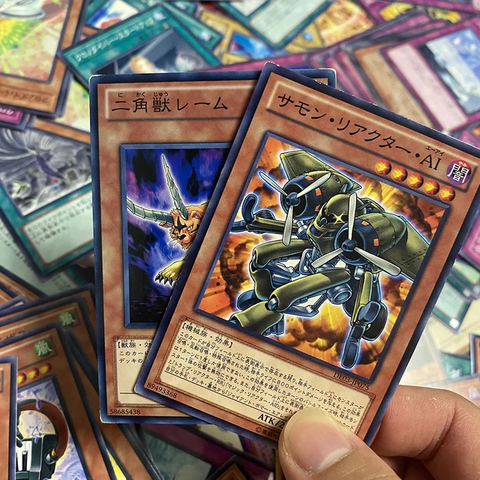
偽物の遊戯王カードを見分ける方法:本物の遊戯王カードの主な特徴:
全体として、「偽物の日本の遊戯王カードを見分けるには?」という質問に答えるために、本物の遊戯王カードを知ることは、遊戯王TCGのバックボーンであり、プレイヤーがデッキを構築し、戦略的な決闘を行うために必要なカードを提供します。コレクターはまた、これらのカードを、そのレアリティと遊戯王フランチャイズにおける歴史的な重要性から大切にしています。
ステップ1:テキストフォントを注意深く調べます。カードの信頼性が不明な場合は、そのテキストを本物のカードのテキストと比較して、不一致がないか確認してください。比較できる物理的なカードがない場合は、オンラインで本物のカードを検索できます。偽物の遊戯王カードは、本物のカードと比較して、特徴的なフォントになっていることがよくあります。このテクニックは、誰かが偽物の遊戯王カードを見分ける方法を尋ねると、さまざまな遊戯王TCGフォーラムでも主に提起されます。
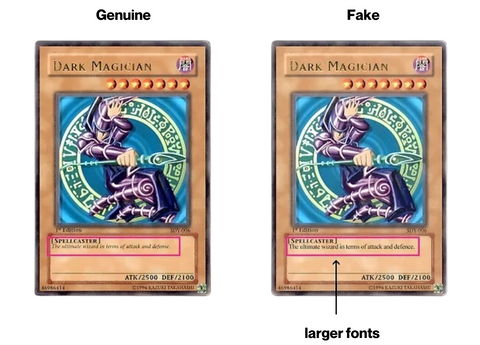
テキストフォントを調べます。
ステップ2:スペルや文法の間違いがないか、効果テキストを調べます。偽造カードは、不正確な翻訳や、記述が不十分な説明になっていることがよくあります。カードの能力と使用法を詳しく説明する下部に通常ある効果テキストを調べて、スペルミスや不自然な文構造がないか確認します。
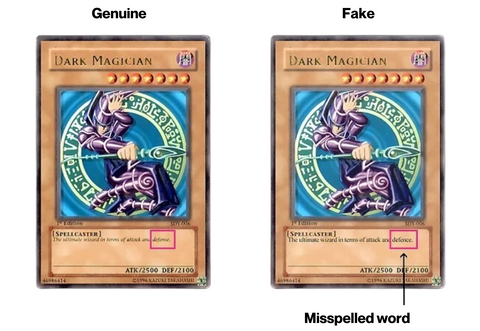
スペルや文法の間違いがないか、効果テキストを確認します。
ステップ3:カードの効果テキストの正しいバージョンを見つけるためにオンライン検索を行い、効果テキストの精度を確認します。次に、単語遣いや言い回しに違いがないか、カードのテキストと比較します。わずかな相違点でも、カードが偽物であることを示しています。

効果テキストの精度を確認します。
ステップ4:カード名に小文字が含まれていないか確認します。本物の遊戯王カードは、モンスターまたは能力の名前を一貫して大文字で表示します。カードを注意深く調べて、その名前に小文字が含まれていないか確認します。もしあれば、カードが偽物であることは明らかです。
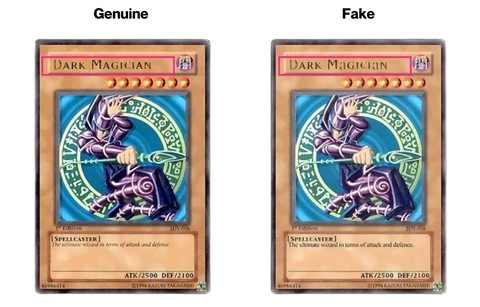
カード名に小文字が含まれていないか詳しく調べてください。
ステップ5:括弧とスラッシュの精度を確認します。すべての遊戯王カードは、魔法、トラップ、またはさまざまなモンスタータイプ(獣、魔法使いなど)などのタイプに分類され、括弧で囲まれ、フォワードスラッシュで区切られています。さらに、モンスターカードには、攻撃力(ATK)と防御力(DEF)の値も含まれ、フォワードスラッシュで区切られています。
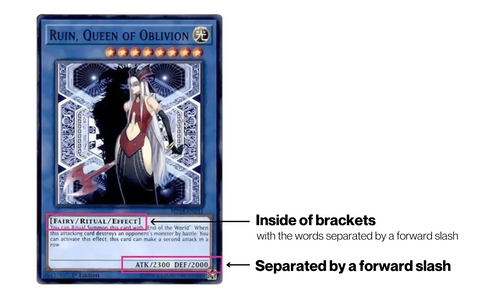
括弧とスラッシュの正しさを評価します。
ステップ1:カードの右上隅にある属性記号を調べます。偽物の遊戯王カードを見分ける方法を学ぶには、カードのすべての詳細、特に記号が必要です。この記号は、上に英語の翻訳が配置された日本語の文字で構成されています。記号がない、英語の翻訳が不正確、または翻訳にスペルミスがある兆候がないか注意深く確認してください。
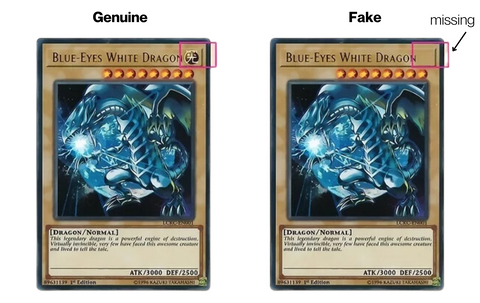
カードの右上にある属性記号を調べます。
ステップ2:モンスターカードのレベルスターを、上、右、および右下の角に焦点を当てて調べます。これらの星はカードのレベルを示しており、赤いオレンジ色のリングで囲まれた5点黄色の星として描かれています。具体的には、レベルスターの上、右、および右下のポイントに注意してください。これらのポイントは、赤いオレンジ色の背景に対してかすかに見えるか、部分的に不明瞭に見える場合があります。星を注意深く調べて、それらがくっきりと見えるかどうか、または目立った違いがないかを確認してください。
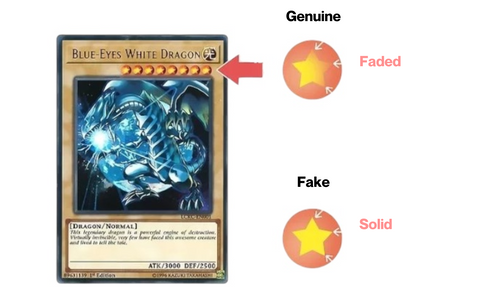
上、右、および右下のポイントでレベルスターの位置合わせを調べます。
ステップ3:問題のカードがエクシーズモンスターカードである場合は、星をチェックするときに、明確な基準を使用します。遊戯王エクシーズモンスターカードにはレベルスターはありませんが、代わりにランクスターがあり、外観がわずかに異なります。ランクスターは、黒い円で囲まれた黄色の5点星として表されます。特に、この星のすべてのポイントは、背景でかすれたり不明瞭になったりすることなく、はっきりと見えるはずです。エクシーズモンスターにこれらの黒いランクスターがない場合、または星のポイントがかすれているように見える場合は、偽物である可能性があります。
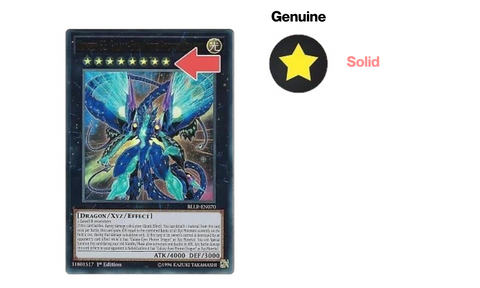
エクシーズモンスターカードの場合は、星を評価するときに異なる基準を適用します
ステップ4:魔法カードとトラップカードに星がないことを確認してください。魔法カードは、効果テキストの上の括弧内に「魔法」または「魔力」のある緑色の背景を持ち、トラップカードは同じ括弧内に「トラップ」のあるピンク色の背景を持ちます。魔法カードにもトラップカードにも、レベルスターまたはランクスターがないはずです。魔法カードまたはトラップカードがこれらの基準を満たしていない場合は、おそらく偽物です。

魔法カードとトラップカードに星がないことを確認します。
ステップ1:カードの角に丸みを帯びたエッジがないか観察します。本物の遊戯王カードは、一貫して黒い枠線と緩やかに湾曲した角を持っています。カードをチェックして、角が尖っているか、鋭角になっているかを確認します。もしそうなら、カードが偽物であることを示しています。
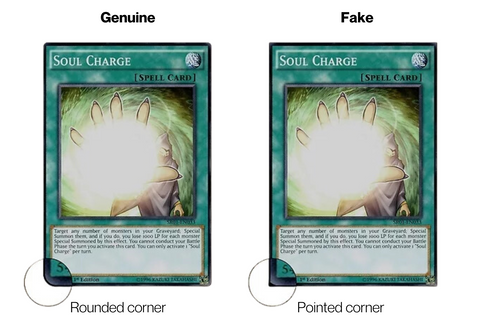
カードのエッジに丸みを帯びた角がないか確認します
ステップ2:指を使ってカードの表面の質感を感じます。指先をカードの表面にそっとこすりつけて、その質感を知覚します。本物のカードは、アートワークの特徴を効果的に反映する隆起した表面を持つ光沢のある仕上がりを持っています。対照的に、偽造カードは平坦で粗い質感を持っています。
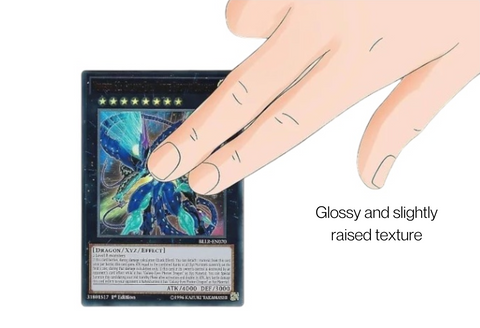
指をカードの表面に沿って動かして、その質感を評価します
ステップ3:カードの境界線の誤カットの兆候を探します。カードの前面と背面の両方をチェックして、境界線に矛盾がないか、または不適切にカットされているように見えるかを確認します。そのような不規則性が見つかった場合は、カードが本物ではないことを示唆しています。このテクニックは、その高度な詳細と継続的な観察により、ユーザーにしばしば課題を突きつけます。したがって、この詳細は、偽物の日本の遊戯王カードを見分ける方法を学ぶときに、専門家によってほとんど見過ごされます。
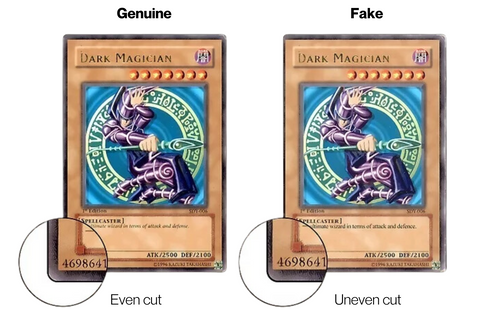
カードの境界線のずれを調べます
ステップ4:カードの右下隅にあるフォイルスタンプを必ず確認してください。本物のカードには、この場所に光沢のある正方形のスタンプがあり、小さい横書きで「Yu-Gi-Oh!」という単語が入っています。偽造カードにはこのフォイルスタンプがない場合や、文字が縦に配置されている場合があります。
注:金色のフォイルは、カードが初回版または限定版であることを意味し、最も価値のある遊戯王カードになります。カードが初回版または限定版としてラベル付けまたは販売されているにもかかわらず、銀色のフォイルスタンプが付いている場合は、偽物です。
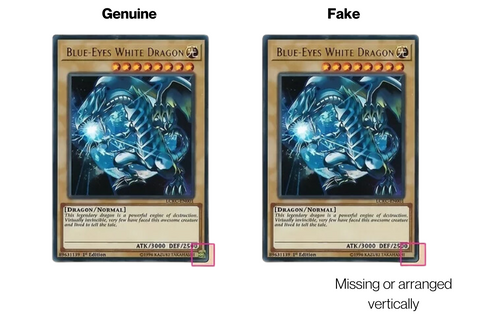
カードの右下隅にあるフォイルスタンプを調べます。
ステップ5:カードの裏側のデザイン、ロゴ、および商標の精度を確認します。遊戯王カードは通常、中央にポータルのような黒い楕円形のある濃いオレンジ色の渦巻き模様の背景を表示します。右下隅には、商標記号が付いた公式の遊戯王ロゴがあります。これらの要素のいずれかが欠落しているか、または誤った位置に配置されているかどうかを確認します。もしそうなら、カードが偽物であることを示しています。

カードの裏側のデザイン、ロゴ、および商標の精度を検証します
ステップ1:カードを取得するときに、カードの名前と統計情報を確認します。評判の良い小売店から購入する場合や、密封されたパッケージでカードを見つけた場合でも同様です。ソースのみに基づいてそれらの信頼性を信頼することは、必ずしも信頼できるとは限りません。カードが本物であり、デッキに適していることを確認するために、正しい名前と正確な統計情報が表示されていることを確認してください。

購入するカードの名前と統計情報を確認します
ステップ2:2枚の同じカードを比較して、違いを探します。オンラインまたは対面でカードを購入する場合でも、販売されたカードを本物のカードと照らし合わせて確認してください。販売されているカードに不一致が見つかった場合は、偽物である可能性が高くなります。
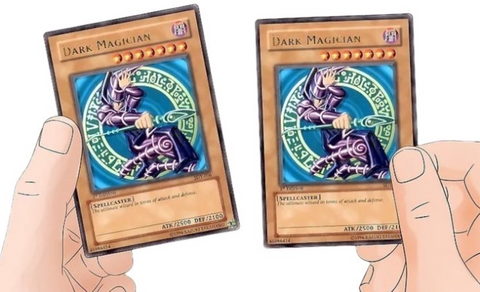
2枚の同じカードを比較して、不一致を特定します
ステップ3:購入する予定のオンラインストアとカードタイプを十分に調査します。事前に遊戯王カードのすべての詳細と統計情報に精通してください。遊戯王公式サイトにアクセスして、正確な情報を入手してください。次に、さまざまなカードタイプの価格と品質の両方に関して肯定
Share:
One Piece Twin Champions OP-06 が登場 & 予約特典
なぜブラックフライデーはブラックフライデーと呼ばれるのか、そしてそのメリット